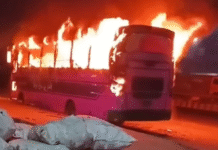COX’S BAZAR, Bangladesh — Bangladesh’s government began its first census of undocumented Rohingya refugees on Thursday, setting off fears that it might lead to a mass relocation or forcible repatriation of the refugees to Myanmar.
The Rohingya, a Muslim ethnic group in western Myanmar described by the United Nations as the most persecuted minority in the world, have crossed the border in waves over several decades.
About 32,000 are sheltered in camps administered by the United Nations, but hundreds of thousands more live undocumented in squalid, makeshift camps or scattered around southeast Bangladesh, vulnerable to human traffickers and exploited as cheap labor.
The population has swelled since 2012, when anti-Muslim riots started taking place with renewed frequency in Myanmar.
The Bangladeshi authorities say the camps are hubs of criminality. Last year, some officials expressed support for a plan to move thousands of refugees to a remote island in the Bay of Bengal that is inundated with water during monsoon season, a notion that was met with anger by the United Nations and then quietly shelved.
In 2013, concerned about swift population growth among the Rohingya, a government team recommended that the United Nations provide rations for no more that two children per family, and that the group’s movements be limited to within two and a half miles of the border with Myanmar.
In 2014, the law minister decreed that officials should no longer register Rohingya marriages. Stories of Rohingya getting picked up by the security forces and being forced to return to Myanmar are common.
As census takers fanned out through Cox’s Bazar, the tin doors of many shacks were marked with the letters CUMN, for “census of the undocumented Myanmar nationals.”
Residents expressed hope that the head count would lift them out of limbo, as well as concern that it could instead lead them to an abrupt return to Myanmar.
“We’re floating people,” said Nuur Samon, an undocumented Rohingya woman who lives in one of the shacks a few hours north of the camps.
“If the government wants to make us move, what can we do about it? Nothing,” she said. “But at least take us somewhere where we can have a community, where we can build schools, where we can have a madrasa. Some place where our husbands can earn an income.”
She added: “We’d like to go back to Myanmar — once it’s safe. Right now it’s still very unsafe for us to return.”
Alamgir Hossen, the Bangladesh Bureau of Statistics official in charge of the project, said estimates of the Rohingya population varied so widely — from 300,000 to 500,000 — that a census was necessary.
Preliminary surveys have already turned up a previously unknown Rohingya community in Patuakhali district much farther to the northwest, dispelling assumptions that the ethnic group is present only near the Myanmar border.
“At first we thought they’d hide from us,” Mr. Hossen said. “We made all our plans accordingly. We were surprised with how open they were with us. People we were surveying would call their neighbors and tell them to give us their information.”
Mr. Hossen and his colleagues enlisted the aid of Rohingya leaders to encourage participation. Dudu Mia, a member of the management committee of the makeshift Leda camp, says he encouraged his community to participate in the census, highlighting the appeal of documentation that could pave the way for resettlement in other countries.
“We need to know how many of us there are,” he said. “We don’t even know this ourselves. Right now we are not counted. At least after this, the world will know how many of us there are.”
Source: nyt










